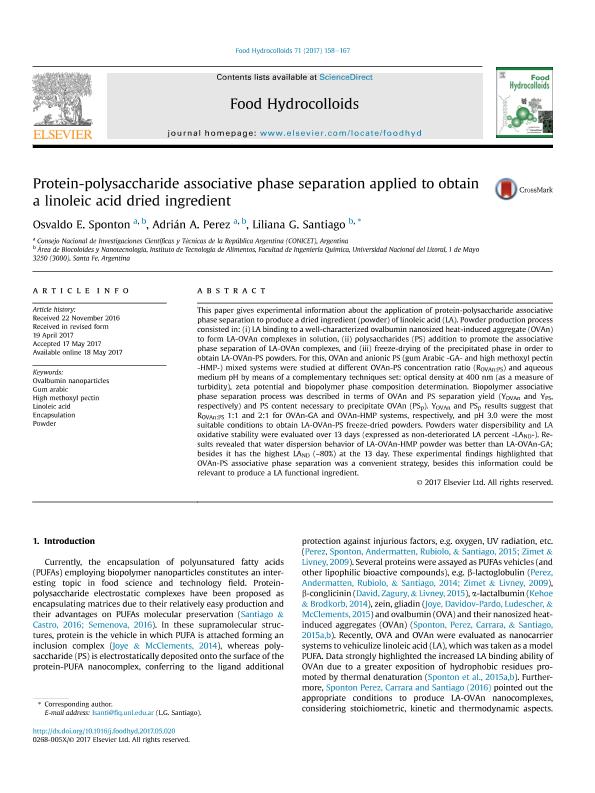Mostrar el registro sencillo del ítem
dc.contributor.author
Sponton, Osvaldo Ernesto

dc.contributor.author
Perez, Adrián Alejandro
dc.contributor.author
Santiago, Liliana G.

dc.date.available
2018-01-17T17:27:23Z
dc.date.issued
2017-10
dc.identifier.citation
Perez, Adrián Alejandro; Sponton, Osvaldo Ernesto; Santiago, Liliana G.; Protein-polysaccharide associative phase separation applied to obtain a linoleic acid dried ingredient; Elsevier; Food Hydrocolloids; 71; 10-2017; 158-167
dc.identifier.issn
0268-005X
dc.identifier.uri
http://hdl.handle.net/11336/33627
dc.description.abstract
This paper gives experimental information about the application of protein-polysaccharide associative phase separation to produce a dried ingredient (powder) of linoleic acid (LA). Powder production process consisted in: (i) LA binding to a well-characterized ovalbumin nanosized heat-induced aggregate (OVAn) to form LA-OVAn complexes in solution, (ii) polysaccharides (PS) addition to promote the associative phase separation of LA-OVAn complexes, and (iii) freeze-drying of the precipitated phase in order to obtain LA-OVAn-PS powders. For this, OVAn and anionic PS (gum Arabic -GA- and high methoxyl pectin -HMP-) mixed systems were studied at different OVAn-PS concentration ratio (ROVAn:PS) and aqueous medium pH by means of a complementary techniques set: optical density at 400 nm (as a measure of turbidity), zeta potential and biopolymer phase composition determination. Biopolymer associative phase separation process was described in terms of OVAn and PS separation yield (YOVAn and YPS, respectively) and PS content necessary to precipitate OVAn (PSp). YOVAn and PSp results suggest that ROVAn:PS 1:1 and 2:1 for OVAn-GA and OVAn-HMP systems, respectively, and pH 3.0 were the most suitable conditions to obtain LA-OVAn-PS freeze-dried powders. Powders water dispersibility and LA oxidative stability were evaluated over 13 days (expressed as non-deteriorated LA percent -LAND-). Results revealed that water dispersion behavior of LA-OVAn-HMP powder was better than LA-OVAn-GA; besides it has the highest LAND (~ 80%) at the 13 day. These experimental findings highlighted that OVAn-PS associative phase separation was a convenient strategy, besides this information could be relevant to produce a LA functional ingredient.
dc.format
application/pdf
dc.language.iso
eng
dc.publisher
Elsevier

dc.rights
info:eu-repo/semantics/openAccess
dc.rights.uri
https://creativecommons.org/licenses/by-nc-sa/2.5/ar/
dc.subject
Ovalbumin Nanoparticles
dc.subject
Gum Arabic
dc.subject
High Methoxyl Pectin
dc.subject
Linoleic Acid
dc.subject
Encapsulation
dc.subject
Powder
dc.subject.classification
Nano-materiales

dc.subject.classification
Nanotecnología

dc.subject.classification
INGENIERÍAS Y TECNOLOGÍAS

dc.title
Protein-polysaccharide associative phase separation applied to obtain a linoleic acid dried ingredient
dc.type
info:eu-repo/semantics/article
dc.type
info:ar-repo/semantics/artículo
dc.type
info:eu-repo/semantics/publishedVersion
dc.date.updated
2018-01-02T14:02:16Z
dc.journal.volume
71
dc.journal.pagination
158-167
dc.journal.pais
Países Bajos

dc.journal.ciudad
Amsterdam
dc.description.fil
Fil: Sponton, Osvaldo Ernesto. Universidad Nacional del Litoral. Facultad de Ingeniería Química. Instituto de Tecnología de los Alimentos; Argentina. Consejo Nacional de Investigaciones Científicas y Técnicas. Centro Científico Tecnológico Conicet - Santa Fe; Argentina
dc.description.fil
Fil: Perez, Adrián Alejandro. Universidad Nacional del Litoral. Facultad de Ingeniería Química. Instituto de Tecnología de los Alimentos; Argentina. Consejo Nacional de Investigaciones Científicas y Técnicas. Centro Científico Tecnológico Conicet - Santa Fe; Argentina
dc.description.fil
Fil: Santiago, Liliana G.. Universidad Nacional del Litoral. Facultad de Ingeniería Química. Instituto de Tecnología de los Alimentos; Argentina
dc.journal.title
Food Hydrocolloids

dc.relation.alternativeid
info:eu-repo/semantics/altIdentifier/url/http://linkinghub.elsevier.com/retrieve/pii/S0268005X1630875X
dc.relation.alternativeid
info:eu-repo/semantics/altIdentifier/doi/http://dx.doi.org/10.1016/j.foodhyd.2017.05.020
Archivos asociados
